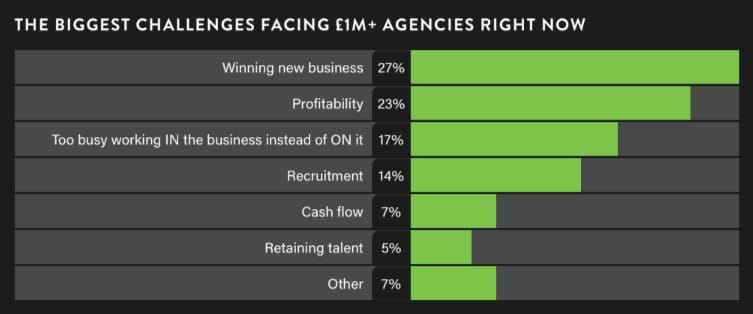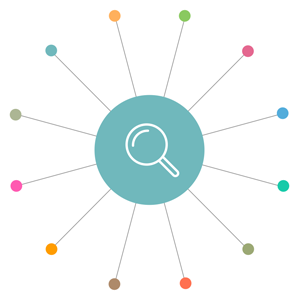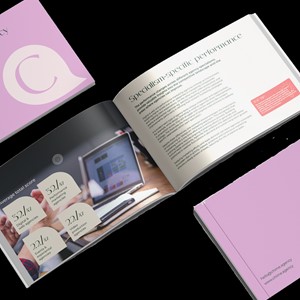The top six challenges facing £1m+ agencies in 2023... and how to tackle them
| In: Trends and insights
Time is everything for agencies. Ultimately, it’s what you sell to keep you profitable. But time can also be an agency’s worst enemy. What worked this time last year might not work now. What was relevant even a few weeks ago now seems like a passing fad.
And as we march through 2023, it seems that time is playing tricks on agencies once again. After a lift in mood and a general sense of businesses moving in the right direction, it seems that confidence levels have dipped and moods have once again shifted into a less positive territory.
But, as the saying goes, this too shall pass.
However, that doesn’t mean staying passive. It means putting in some actions and activity right now to address current issues, so you’ll once again emerge victorious.
In its report State of the Agency Nation, Benchpress highlights the challenges agencies have told them are affecting them the most.

Let’s look at the top six challenges facing £1m+ agencies and how you can rise to meet them.
1. Winning new business
Industry-leading agency management consultants Agency Works recommend that 75% of an agency’s income should come from existing clients. And it’s easier to upsell to existing clients than it is to chase completely new business. So this is an excellent place to start. Building good relationships with your clients is pivotal. If you deliver good work, they’re more likely to trust you with other projects. Make sure they know exactly what your agency can offer beyond your existing jobs and highlight any areas you think you could work together further.
The agency world can be a competitive one, so make sure you have strong positioning and a proposition that elevates you above your competition. Ensure your branding and your work is beautifully presented everywhere it’s seen, from your website to your walls.
Strong networks and relationships are key, too. This builds on the earlier point about working with existing clients but extends into wider areas. Leaders with excellent contacts and a good reputation within the industry will more easily attract the eye of potential new business leads.
A focused targeting strategy and linked activities will also serve you well here. There’s no point just cold calling everyone you can think of. But curated initiatives geared towards clients you actually want to work with can reap rewards. Why do you want to work with them? What can you offer to give added value? Sell them the benefits of working together rather than desperately casting your net too wide.
A perfect sales process and pitching technique will stand you in good stead, too, promoting your agency without being overly salesly.
2. Profitability
One of the big barriers to profitability is overservicing. Essentially, giving your time away free to clients. If you can stop overservicing, you could see a change in your agency’s fortunes.
Good timesheeting can help you see exactly how long a previous similar project took, and you can be more accurate with your estimating. Getting to know your clients and their habits can help here. Some have a tendency to keep adding little requests here and there, or they want long and involved meetings at every step of the way. Knowing this can help you build an accurate estimate.
A clear understanding of the brief is essential in order to avoid scope creep. If the brief changes dramatically from its initial stages then you need to stop and reconsider your estimate.
Some agencies do take the commercial decision to do a little extra work they don’t charge for, to preserve the good working relationship with a client. But don’t work for free in secret. Tell your client what the real estimate is and how this is different to what you’ll be charging. This is great for strengthening your relationship, a reward for their loyalty in choosing to keep working with you, and means they’ll likely keep doing so for future projects.
You can also carry out a debrief after a project, so you can see how profitable it really was. Helping you to understand which projects, clients and services are the most profitable, and if there are any clients which are not actually worth keeping on.
Selling the right time is important, too. While it can be tempting just to take on every job which comes your way, you need to know that you’ve got enough people and they’ve got enough hours. This means monitoring your capacity carefully and planning ahead.
If all your design teams are busy, taking on more design work will just overload them and lead to issues, while your web team is sitting around twiddling their thumbs.
Getting a good overview of who’s available and what could be coming in will help you plan properly, and decide if you can take on new projects, if you need freelancers or even if you need to recruit.
Keeping your talent in-house is another good step towards long-lasting profitability. Bringing the right people in to start with is key, but making them feel valued, offering competitive wages and benefits and having a career progression path for those that want it will help to retain these people. A little appreciation goes a long, and profitable, way.
Read our full guide: Six ways to build a more profitable agency
3. Too busy working IN the business instead of ON it
This is an understandable one. You’re managing your day-to-day work, people and all the other associated plate-spinning associated with running an agency.
But you do need to be looking at longer-term strategy to grow your agency and stay competitive.
Here’s some great advice from agency leadership coach Kate Waterfall Hill:
“When you are a leader, particularly in a small or medium-sized business, and even more so when you're the founder/entrepreneur, it's very easy to be busy all the time trying to be everything to everyone. You wear all the hats and think you need to solve all the problems.
“Actually, your job is to set the strategy, provide the vision and find the resources to make it happen. Block out time to allow yourself the opportunity to think strategically. Stop being a "doer" and start being a ‘thinker’, a ‘planner’ and a ‘visionary’. Your people will follow you if they understand the vision, the purpose and their role in the bigger picture.
“Plan for the future. Plan for unforeseen and predictable issues that might arise. Plan to be flexible (that sounds like a contradiction but it's not – in order to be agile you need to have some space/resources to be able to redeploy and respond to change). You can't do everything if you've got no time to work out how to react.
“While you need to get things done, it's better to get others who are experts in the field to do them rather than trying to do everything yourself — they will do it better and faster if you give them a good brief. Delegating well will give you time to think.”
4. Recruitment
When someone leaves, often the immediate temptation is to recruit externally. But a good idea is to look within to see if there’s someone you could promote into the position.
If you do decide to recruit externally, establish which is the best method or range of methods for your agency. Word of mouth in the creative industry is often a rich source of prospective candidates, so ask your team members if they know anyone suitable. LinkedIn can also be useful, to see who’s looking for work.
Make sure you have a really strong brand positioning and employee proposition that elevates you above your competition. You want your agency to be inviting and enticing, so talk about the wider elements such as socials, charity work and career progression.
When you interview, remember you’re looking for someone who’s a good fit in person, not just on paper. A good skillset on a CV doesn’t always translate into a good fit for your agency.
It’s also a good idea to do some post-hire analysis, to figure out what worked and what didn’t, to incorporate into your future recruitment processes.
5. Cash flow
You’ve all been busy for as long as you can remember, but the bank balance isn't balancing. Cash flow is a big challenge for agencies and an important one to tackle to keep you profitable.
You can look at this as a three-pronged approach:
1. Get money coming in quickly
Some jobs roll on for months, you invoice at the end then you wait another month or two to be paid. If you know a job is likely to follow this pattern, why not see if you can invoice upfront? Or incrementally at each completed phase of the project. Billing plans will keep your cash flowing nicely.
When you send an invoice, politely check it’s been received and ask for a payment date. If you don’t receive payment by this date, chase it up promptly but courteously (it’s always worth being on good terms with the accounts people in your clients’ teams!)
2. Manage spending and costs
Purchase and expenses software can help you get a good view of what’s being spent and see how to control this. For example, you can set up purchase approval workflows, spending limits and add defined mark-ups at supplier or client level.
Good software will also help you keep track of when costs are due in and double check payment terms, so you know what you’re going to be invoiced and when you need to pay them.
3. Revenue management
It can be easy to fall into the trap of thinking of accrued revenue is profit. For example, a client asks you to pre-invoice to fit in with their financial year or budget dates, but you might not complete the actual project until later - this is 'accrued revenue'. Or you might receive goods or services from a supplier but not receive an invoice for a while, aka 'accrued costs'.
Using a system which offers you revenue management can help you allocate revenue to the correct month and understand your actual profits.
6. Retaining talent
Happy people are productive people.
But there are lots of agencies out there trying to entice talent through their doors. Making your agency a lovely place to work is a great start. But you also need to look at tangible stuff like salary, progression and policies to really keep your people where you want them: right there with you.
Are your salaries competitive compared to industry standards? Do you offer career progression to those that want it? Do you have good flexible working opportunities, sickness and absence policies, a wellbeing programme?
Make sure you’re listening to your people, too. You could encourage informal feedback or operate a more formal employee survey system. Whichever you do, make sure you take action.
Realistically, people will sometimes leave. Exit surveys can be helpful here, so you can understand if you could have persuaded them to stay, or if the reasons they’re leaving are out of your hands, such as moving house.
Being a good employer, recognising and rewarding hard work and really appreciating the talent you have will pay dividends.
When you’re faced with challenges from seemingly every direction, it can be difficult to see the wood from the trees. But taking a calm and strategic approach will help you to find the right solutions for your agency. A good agency management system will support you here, giving you a good overview of everything that’s happening within your agency so you can make informed plans and decisions.
If you’d like to find out more about how Synergist could help you tackle these challenges, book a demo

 How to turn data into insights using Synergist
How to turn data into insights using Synergist  Key findings from the 2024 Agency Marketing Benchmark Report
Key findings from the 2024 Agency Marketing Benchmark Report  Great Agency Reads
Great Agency Reads